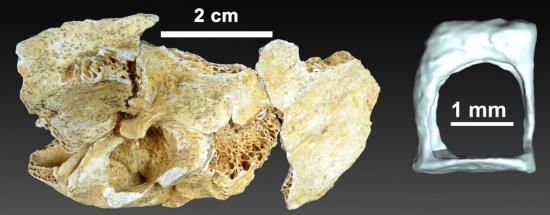New remains recovered in an excavation carried out over 40 years ago have enabled this auditory ossicle to be reconstructed
University of the Basque Country
Source - http://www.eurekalert.org/pub_releases/2015-03/uotb-tso032715.php

A 3-D reconstruction of the auditory ossicle of a two-year-old Neanderthal. CREDIT UPV/EHU
The Neanderthals (Homo neanderthalensis) inhabited Europe and parts of western Asia between 230,000 and 28,000 years ago; during the last few millennia they coincided with Homo Sapiens Sapiens, and became extinct for reasons that are still being challenged. The archaeological site at La Ferrassie, excavated throughout the 20th century, is a mythical enclave because it was where 7 Neanderthal skeletons, ranging from foetuses to almost complete skeletons of adults, were found.
Among the remains discovered at La Ferrassie is the skeleton of a 2-year-old Neanderthal child found between 1970 and 1973 and baptised La Ferrassie 8; over 40 years since its discovery it has turned out to be useful in shedding new light on the anatomy of this extinct species.
The study began by reviewing the collections at the Muséum National d'Histoire Naturelle in Paris and at the Museo d'Archéologie national de St. Germain-en-Laye linked to the excavations at La Ferrassie in 1970 and 1973; it was there that 47 new fossils belonging to La Ferrassie 8, which complete its skeleton further, were recovered. Remains of a skull, jaw, vertebrae, ribs and hand phalanges were found among the new fossils.
Featuring among the remains is a very complete left temporal bone and an auditory ossicle was found inside it: a complete stapes. Virtual 3D reconstruction techniques enabled this ossicle to be "extracted virtually" and studied.
This stapes is the most complete one in the Neanderthal record and certifies that there are morphological differences between our species and the Neanderthals even in the smallest ossicles in the human body. As Asier Gómez-Olivencia pointed out, "we do not yet know the relation between these morphological differences and hearing in the Neanderthals. This would constitute a new challenge for the future".
The study of these new remains has been published in the prestigious Journal of Human Evolution, and has also had the participation of researchers of the CNRS (French National Centre for Scientific Research) in Paris and Bordeaux. The fact that a discovery of such significance has been made thanks to reviewing the remains excavated in the 1970s provides the researcher with proof of "the importance and need to review old excavations. We're in no doubt about that".
###
Asier Gómez-Olivencia, a doctor in Human Palaeontology, did research at the University of Cambridge and at the Muséum National d'Histoire Naturelle in France, until 2014 when he joined the UPV/EHU's Department of Stratigraphy and Palaeontology as an Ikerbasque Research Fellow.
Bibliographic reference: http://www.sciencedirect.com/science/article/pii/S0047248415000275